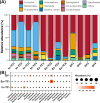Unraveling the gut microbiota of Tibetan chickens: insights into highland adaptation and ecological advantages
- PMID: 39345125
- PMCID: PMC11536995
- DOI: 10.1128/spectrum.00519-24
Unraveling the gut microbiota of Tibetan chickens: insights into highland adaptation and ecological advantages
Abstract
Tibetan animals have several unique advantages owing to the harsh ecological conditions under which they live. However, compared to Tibetan mammals, understanding of the advantages and underlying mechanisms of the representative high-latitude bird, the Tibetan chicken (Gallus gallus, TC), remains limited. The gut microbiota of animals has been conclusively shown to be closely related to both host health and host environmental adaptation. This study aimed to explore the relationships between the cecal microbiome and the advantages of TCs based on comparisons among three populations: native TCs residing on the plateau, domestic TCs living in the plain, and one native plain species. Metatranscriptomic sequencing revealed a significant enrichment of active Bacteroidetes but a loss of active Firmicutes in native TCs. Additionally, the upregulated expression of genes in the cecal microbiome of native TCs showed enriched pathways related to energy metabolism, glycan metabolism, and the immune response. Furthermore, the expression of genes involved in the biosynthesis of short-chain fatty acids (SCFAs) and secondary bile acids (SBAs) was upregulated in the cecal microbiome of native TCs. Data from targeted metabolomics further confirmed elevated levels of certain SCFAs and SBAs in the cecum of native TCs. Based on the multi-omics association analysis, we proposed that the higher ratio of active Bacteroidetes/Firmicutes may be attributed to the efficient energy metabolism and stronger immunological activity of native TCs. Our findings provide a better understanding of the interactions between gut microbiota and highland adaptation, and novel insights into the mechanisms by which Tibetan chickens adapt to the plateau hypoxic environment.
Importance: The composition and function of the active cecal microbiome were significantly different between the plateau Tibetan chicken population and the plain chicken population. Higher expression genes related to energy metabolism and immune response were found in the cecal microbiome of the plateau Tibetan chicken population. The cecal microbiome in the plateau Tibetan chicken population exhibited higher biosynthesis of short-chain fatty and secondary bile acids, resulting in higher cecal content of these metabolites. The active Bacteroidetes/Firmicutes ratio in the cecal microbiome may contribute to the high-altitude adaptive advantage of the plateau Tibetan chicken population.
Keywords: active Bacteroidetes/Firmicutes ratio; active microbiome; innate immune activity; multi-omics; secondary bile acids; short-chain fatty acids.
Conflict of interest statement
The authors declare no conflict of interest.
Figures







Similar articles
-
Altitude-adaption of gut microbiota in Tibetan chicken.Poult Sci. 2022 Sep;101(9):101998. doi: 10.1016/j.psj.2022.101998. Epub 2022 Jun 10. Poult Sci. 2022. PMID: 35841636 Free PMC article.
-
High-throughput sequencing technology to reveal the composition and function of cecal microbiota in Dagu chicken.BMC Microbiol. 2016 Nov 4;16(1):259. doi: 10.1186/s12866-016-0877-2. BMC Microbiol. 2016. PMID: 27814685 Free PMC article.
-
Cecal microbiota of Tibetan Chickens from five geographic regions were determined by 16S rRNA sequencing.Microbiologyopen. 2016 Oct;5(5):753-762. doi: 10.1002/mbo3.367. Epub 2016 May 2. Microbiologyopen. 2016. PMID: 27139888 Free PMC article.
-
Recent progress in research on the gut microbiota and highland adaptation on the Qinghai-Tibet Plateau.J Evol Biol. 2021 Oct;34(10):1514-1530. doi: 10.1111/jeb.13924. Epub 2021 Sep 8. J Evol Biol. 2021. PMID: 34473899 Review.
-
The effects of gut microbiota on appetite regulation and the underlying mechanisms.Gut Microbes. 2024 Jan-Dec;16(1):2414796. doi: 10.1080/19490976.2024.2414796. Epub 2024 Nov 6. Gut Microbes. 2024. PMID: 39501848 Free PMC article. Review.
References
-
- Hu L, Long J, Lin Y, Gu Z, Su H, Dong X, Lin Z, Xiao Q, Batbayar N, Bold B, Deutschová L, Ganusevich S, Sokolov V, Sokolov A, Patel HR, Waters PD, Graves JAM, Dixon A, Pan S, Zhan X. 2022. Arctic introgression and chromatin regulation facilitated rapid Qinghai-Tibet Plateau colonization by an avian predator. Nat Commun 13:6413. doi:10.1038/s41467-022-34138-3 - DOI - PMC - PubMed
MeSH terms
Substances
Grants and funding
LinkOut - more resources
Full Text Sources

